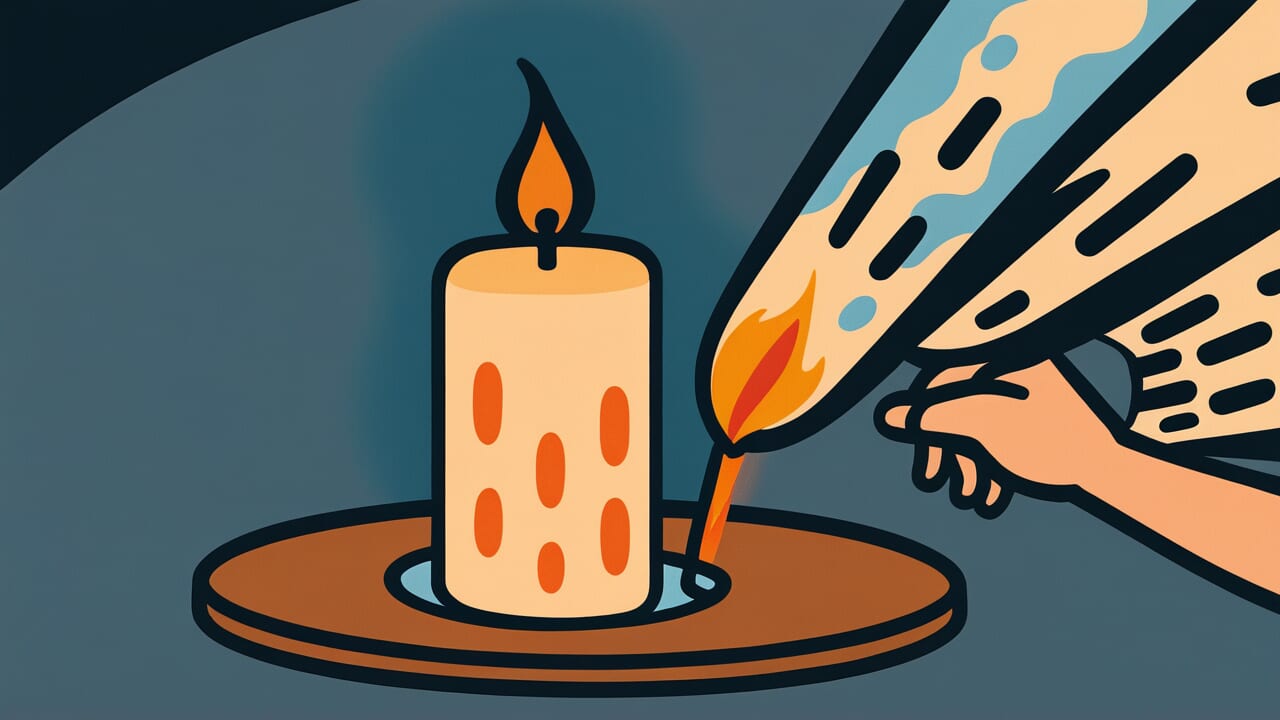How to Read “the candle that burns twice as bright burns half as long”
The candle that burns twice as bright burns half as long
[the CAN-dul that burns twice as bright burns half as long]
All words use standard pronunciation.
Meaning of “the candle that burns twice as bright burns half as long”
Simply put, this proverb means that living intensely or working too hard will shorten your life or success.
The saying uses a candle as a comparison. If you make a candle burn brighter by turning up the flame, it will use up the wax much faster. The same thing happens with people who push themselves too hard. They might achieve more in a short time, but they burn out quickly.
We use this wisdom when talking about workaholics who damage their health. It applies to athletes who overtrain and get injured. It fits students who study all night and crash during exams. The message is that extreme intensity comes with a serious cost.
People often realize this truth too late in life. They spend years chasing success at full speed. Then they wonder why they feel exhausted or sick. This proverb reminds us that sustainable effort usually beats intense bursts. It suggests that pacing yourself leads to better long-term results.
Origin and Etymology
The exact origin of this specific phrase is unknown. However, the concept appears in various forms throughout history. The idea connects to ancient observations about fire and light sources.
People have always noticed that brighter flames consume fuel faster. This basic truth about combustion became a natural comparison for human behavior. Ancient cultures used oil lamps and candles daily. They understood the trade-off between brightness and duration very well.
The saying gained popularity through literature and philosophy over centuries. Writers used candle metaphors to discuss life and death. The phrase spread through books, speeches, and conversations. Today it appears in movies, songs, and everyday discussions about work-life balance.
Interesting Facts
The word “candle” comes from Latin “candela,” meaning “to shine” or “to glow.” This connects to the same root that gives us “candid” and “incandescent.”
Candles actually do burn faster when the flame is larger. A bigger flame creates more heat, which melts the wax quicker and uses more oxygen. This makes the proverb scientifically accurate as well as metaphorically meaningful.
The phrase structure uses parallel construction with “twice as bright” and “half as long.” This creates a memorable rhythm that helps people remember the saying.
Usage Examples
- Manager to employee: “I’m worried about your 80-hour weeks and constant overtime – the candle that burns twice as bright burns half as long.”
- Parent to teenager: “Partying every night and cramming for exams isn’t sustainable – the candle that burns twice as bright burns half as long.”
Universal Wisdom
This proverb reveals a fundamental tension in human nature between intensity and sustainability. We are creatures driven by both ambition and the need for preservation. Our minds push us toward achievement while our bodies demand rest and recovery.
The wisdom speaks to our difficulty in understanding limits. Humans often believe we can override natural boundaries through willpower alone. We see successful people working extreme hours and assume this is the path to greatness. Yet the proverb suggests that nature always collects its debt. The energy we borrow from tomorrow must eventually be repaid.
This saying also captures our struggle with time itself. We want to pack as much living as possible into our years. The fear of missing out drives us to burn brightly in every moment. But the proverb warns that this approach might actually reduce our total experience. Sometimes the tortoise really does beat the hare, not through speed but through endurance and consistency.
When AI Hears This
Humans consistently underestimate the hidden costs of pushing too hard. When someone works eighteen-hour days, they think they’re being three times more productive. But their brain actually starts making more mistakes after hour ten. Their body needs extra recovery time that wipes out the gains. The real energy cost isn’t double or triple – it’s often five times higher than normal pace.
This happens because human brains are terrible at seeing compound effects. We notice the immediate output but miss the invisible damage building up. A student cramming all night sees the extra study hours clearly. They don’t see their immune system weakening or memory formation breaking down. Our minds evolved to track simple cause and effect, not complex systems with delayed consequences.
What’s remarkable is that humans keep making this mistake despite constant evidence. Every culture has stories about burnout, yet each generation rediscovers it personally. This isn’t stupidity – it’s actually smart short-term thinking. Sometimes you really do need that burst of intensity to survive. The problem is our brains can’t easily switch between emergency mode and sustainable mode.
Lessons for Today
Living with this wisdom means learning to recognize your own burning patterns. Some people naturally burn bright and need to practice dimming their flame. Others burn too dimly and miss opportunities for meaningful intensity. The key is understanding which type you are and when each approach serves you best.
In relationships and work, this wisdom helps us spot unsustainable patterns early. When someone constantly works late or never takes breaks, we can gently point out the candle principle. When we see friends pushing too hard in any area, we can remind them that consistency often beats intensity. The goal is not to avoid all bright burning, but to choose when it is worth the cost.
Communities benefit when they honor both the bright burners and the steady flames. Some projects need intense short-term effort. Others require patient, long-term commitment. The wisest groups learn to match the right people to the right situations. They also create systems that prevent anyone from burning out completely while still allowing for periods of high intensity when necessary.



Comments